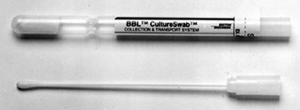Upper Respiratory Culture of the nares, mouth, oropharynx (throat) and nasopharynx
POWERCHART ORDER – Upper Respiratory Culture
Useful For
- Upper respiratory specimens, which include the nares, mouth, oropharynx (throat) and nasopharynx, are obtained to; determine the etiology of a pharyngitis, diagnose oral yeast infection, or detect the carrier state of a pathogen (MRSA).
- The most common causative agent of pharyngitis is Group A Streptococcus. Infrequently, pharyngitis may also be caused by: other Beta hemolytic Streptococci (primarily groups C&G) or Arcanobacterium haemolyticum. (A. hemolyticum may also cause peritonsillar abscess) N. meningitidis or N. gonorroheae may also be implicated, however special culture methods are generally required for growth and they are therefore not commonly isolated.
Method Name
Culture
Aliases
Upper,respiratory,culture,throat,mouth,nares,pharynx,oropharynx,nasopharynx
Specimen Type
- Collect specimens with a Culturette swab E swab Mini tip swab, making sure to break the media ampule after collection.
- For throat cultures, a swab should be passed posteriorly, taking care to avoid the oral mucosa and tongue. One tonsillar area should be swabbed and the swab then drawn to the other tonsillar area across the posterior pharyngeal wall.
- Material collected from the nares should be from the anterior portion of the nose. Cultures of the mouth are generally not rewarding unless an abscess is present. Material should be taken from the site of the abscess.
- To collect nasopharyngeal specimens, a Mini tip E swab should be passed along the floor of the nose posteriorly until it contacts the posterior pharyngeal wall.
- Access to the para nasal sinuses requires needle aspiration or surgical intervention. Swabs of nasal sinuses, which do not originate from the OR or an ENT specialist, should be treated as Nasopharyngeal specimens.
- ENT or OR Specimens require a Wound Culture – Surgical order.
- Specimens may be held at room temperature for up to 2 hours after collection. Beyond 2 hours, loss of fastidious organisms may occur. Do not refrigerate specimens. Dry swabs are unacceptable for culture.
- Cultures taken specifically for the recovery of: N. gonorroheae, N. meningitidis, B. pertusis or C. diptheriae require special handling – see Procedure Notes – “Special Orders”.
Specimen Required
Culturette or E-swab of throat, nasopharynx, paranasal sinuses, mouth or nares (dual swab preferred) or minitip culturette swab.


Specimen Minimum Volume
1 Swab (2 preferred)
Specimen Stability Information
Transport at room temperature.
- Specimens may be held at room temperature for up to 2 hours after collection. Beyond 2 hours, loss of fastidious organisms may occur.
- Do not refrigerate specimens.’
- Dry swabs are unacceptable for culture.
- Culturette or E-swabs are stable for 48 hour after collection.
*NOTE* Specimens that do not meet the above criteria will be rejected.
Rejected Due To
- Non preserved specimens more than 2 hours old at room temperature after collection. Beyond 2 hours, loss of fastidious organisms may occur.
- Refrigerated specimens.
- Dry swabs are unacceptable for culture.
- Culturettes with transport media or E-swabs received more than 48 hour after collection.
Special Instructions
- Specimens must be labeled with complete source and body site information.
- Upper respiratory specimens, which include the nares, mouth, oropharynx (throat) and nasopharynx, are generally obtained to determine the etiology of a pharyngitis, diagnose oral yeast infection, detect the carrier state of a pathogen or detect shifts in pathogenic flora in immunosuppressed patients.
- Direct smears and susceptibility testing are not routinely performed.
- Culture of the mouth or areas in the oral cavity other than the tonsillar area or pharynx, when a bacterial pharyngitis is suspected, may yield falsely negative culture results.
- Routine screening of upper respiratory cultures may not identify some of the rarely occurring pathogens of the upper respiratory tract. These may include; Klebsiella ozaenae, Klebsiella rhinoscleromatis, Corynebacterium ulcerans, Actinomyces pyogenes and others. Specific diagnostic information must be provided on the Lab Request in order screen for these pathogens.
- Swabs of the paranasal sinuses, if not taken during surgery, are actually sinus drainage specimens. These specimens, by their nature, are contaminated with upper respiratory flora and are not necessarily reflective of the etiology of a sinusitis.
- Special media and transport devices are needed for the recovery of Neisseria gonorrohea. Routine throat swabs are not adequate for the diagnosis of GC in the throat.
- Special culture methods are required for the identification of Corynebacterium diptheriae.
Special Orders:
- This laboratory does not routinely identify Neisseria in throat specimens. Cultures taken specifically to rule out N. gonorroheae or N. meningitidis should state this on the lab request and should be submitted directly on an “in tray” GC culture device (see GC Culture Protocol).
- Specimens for B. pertussis or C. diptheriae are sent to reference laboratories. Pertussis screening may be done by either culture or PCR methodology. Special collection kits are available for each. Specimens for Diptheria culture should be submitted on Culturette swabs.
Performing Laboratory
Glens Falls Hospital Microbiology Laboratory
Reference Values
No pathogens observed
Day(s) and Time(s) Performed
- Day Shift
- 7 days per week
Analytical Time
Up to two days
Specimen Retention Time
Specimen held 72 hours
Analytical Time
Up to two days
